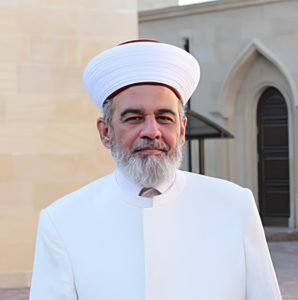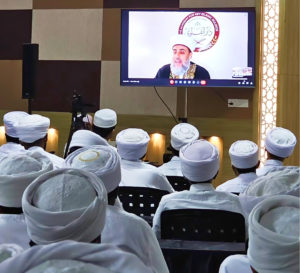On the occasion of the advent of Ramadan of this year, as is the case every year, many people pose the question ” do we need to observe the crescent of Ramadan to establish the beginning of fasting when we live in the era of the Internet and Google Earth!?”
The answer to this question requires a simple introduction.
Some nations, for the purpose of knowing the twelve months of the year, rely upon the Gregorian solar calendar system, a technical term the people have come to acknowledge, and some rely upon the lunar calendar system, which is a natural system that relies upon the movement of the moon.
The Arabs have adopted the Lunar system and established that the month is the duration between sighting the moon and sighting it again as documented in Subh Al-A^sha authored by Al-Qalqashandi (821AH). The Qur’an stated this function of the moon clearly in surah Al-Baqarah, Ayah 189 “يسألونك عن الأهلة قـل هي مواقيت للناس والحج” which means [ …they ask you about the beginnings of the moons, so tell them they entail establishing for the people the time frames and establishing the time to perform pilgrimage.] Ahillah in the Ayah is the singular form of Hilal which means the beginning of the moon as documented in Lisan Al-Arab authored by Ibn Mandhour (711AH)
Early on, while we are still in the month of Sha^ban, statements are issued to announce the beginning of the blessed month of Ramadan, leading to an increased difference in the word of the Muslims. Some adopt the opinion that it is possible both scientifically and religiously speaking, and some say it is not possible scientifically and/or religiously.
I wish those who issue such statements if they would ask themselves about the lay people among the Muslims who have no access to the modern tools of observatories and computers. Islam did not decree that obligatory acts of worship are contingent upon such tools and consequently every man who satisfies the required conditions is obligated to perform them, despite of ones degree of education, hearing and sighting abilities. Especially so, that fasting is obligatory on the Muslims in Shinqit as well as on the Muslims of the affluent societies that are occupied in the “civilization” of Television and Internet.
We tell them if you wish to unite the word of the Muslims through adopting one date for the beginning and ending of fasting, then why you don’t embrace one time for the five prayers or at least the Friday Prayer!? Should they say this is not possible due to that the location of the sun differs during the day from one country to another, and people inhabit different countries, we tell them, likewise, the beginning and ending of the month of fasting is contingent upon the locations of the moon and its different rising points at night. So where is the problem with that!?
Moreover, there are important matters that we ought to elucidate:
1) Allah the exalted did not decree that the beginning of fasting be contingent upon the birth of the moon or the ability to sight it. Rather, Allah decreed that this honorable act of worship be contingent upon the actual physical sighting of the moon, and if not sighted as such then it is incumbent upon one to eliminate the doubt by completing thirty days of Sha^ban as per the well known Hadith “صوموا لرؤيته وأفطروا لرؤيته فإن غمّ عليكم فأكملوا عدة شعبان ثلاثين يوماً”, which means ” Begin and end fasting when you sight the crescent and if you are blocked from sighting it then complete thirty days of Sha^ban.” Narrated by Al-Bukhari (256AH) and Muslim ( 261AH).
This hadith clarifies that Allah who sets the rules did not make fasting contingent upon the birth of the moon, because its birth differs with the different locations and countries. This encompasses much wisdom, one of which is protection against the overlap of the months. Hence, what would the people do if the astronomers differ about the time of the birth of the moon, the time of the possibility of sighting it or about its location? Especially that the rules of the religion are not based on possibilities, because whatever encompasses possibilities loses the element of being a point of proof, as per the well known rule among the scholars of the fundamentals of jurisprudence. Beyond doubt, this matter involves several possibilities and not one.
Just as the case turns out to be for Ramadan of this year 1426AH., The Greenwich Royal Observatory of England, www.rog.nmm.ac.uk, says the crescent will appear on Wednesday October 5th, 2005 and hence Ramadan will begin Thursday the 6th. On the other hand according to the Observatory of the USA Navy, as per posting on their web page aa.usno.navy.mil/faq/docs/islamic.html, Ramadan will begin Tuesday the 4th.The difference between both Observatories is two days and not one.
So in this situation which of the two do we go by?! Should the people of Basra begin fasting according to the timing of the English observatory and the people of Baghdad fast according to the timing of the American observatory?! And by whose timing should we begin fasting?!
2) The tabulations that show the time frames for the New Moon and the First Visibility that are posted on the web by the University of Princeton in the USA—one of the most famous worldwide, clearly show that there is a clear difference between the time of the birth of the New Moon and the time of its first visibility that can amount to one or two days. This is clear in several posted dates http://www.eyeonthesky.com/aaap2.html (see below.)
3) Even though one might say that the time of the birth of the New Moon can be determined accurately to a large degree, still the famous observatories of the Universities corroborate that it is not possible to determine the time of the First Visibility, as determined by the Universities of Princeton, Harvard, Cornell, Ohio, Maryland in the USA and The British Royal Nautical Almanac of England.
I have corresponded with all of them and all unanimously agree that the visibility is linked to several uncontrollable factors such as the measure of the angle between the two locations of the sun and the moon at the point of the possibility of observation, the speed of the moon in its course at the point of the possibility of observation.
Moreover, there is an important consideration for the distance between the observer and the Moon, and fourthly, one must take into consideration the position of the observer alongside the effect of sunlight at sunset in the horizon where the Moon is expected to be sighted. All of that is uncontrollable by the human being.
The text attributed to the US Naval Observatory agreed upon by all the above mentioned observatories is: The date and time of each New Moon can be computed exactly, but the time that the Moon first becomes visible after the New Moon depends on many factors and cannot be predicted with certainty. (aa.usno.navy.mil/faq/docs/islamic.html (.
4) The months of the Lunar year are not always thirty days but could be 29 complete days as stated in the hadith of Al- Bukhari and Muslim ” …the month is either 30 days or 29 days”. It is known also that the Lunar astronomical month is slightly different in that it is on the average 29 days and one half day.
Hence, Allah who created the rules did not decree that fasting be contingent upon the beginning of the month astronomically or the sighting of the crescent via calculations due to the hardship involved and to the inherent lack of ability. The religion offers facilities and not hardships and not everyone has access to an observatory and not everyone who uses an observatory is trustworthy and reliable.
5) Knowing the beginnings and endings of the Arabic Months by calculating the time of the birth of the New Moon is a matter that is not mentioned in the honorable hadith or other religious texts, whether Qur’an or Sunnah. The claim to perform Ijtihad in this context is discredited because of the prohibition to perform ijtihad when a text is available.
Ijtihad is applicable when a religious text about the subject is not available. The function of the Mujtahid when performing ijtihad is to deduce the religious judgment through a comparative analogy (qiyas) where he compares a matter that lacks a religious text to a matter that has a religious text conveyed by the impeccable prophet, sallallahu ^Alayhi wa sallam, chosen for a similar analogy that exist between the two matters.
It is not the function of the Mujtahid to initiate a religious ruling and more so when it contradicts the aforementioned hadith which is unanimously agreed upon, both, as Sahih and to apply “صوموا لرؤيته وأفطروا لرؤيته فإن غمّ عليكم فأكملوا عدة شعبان ثلاثين يوماً”, which means, ” begin and end fasting when you sight the crescent and if you are blocked from sighting it then complete thirty days of Sha^ban.”,
Lastly we say it is not unknown that this matter is religiously invalid, over and above that it is unattainable by calculations as we have shown. This is so due to the contradiction it poses with the Qur’an, Hadith, and Ijma^ (unanimous agreement of the scholars) whose jurisdiction was deduced by Imam Ash-Shafi^iyy (204AH) in his book Ahkam Al-Qur’an from the saying of Allah in surah an-Nisa’, Ayah 115 “ومن يشاقق الرسول من بعد ما تبيّن له الهدى نوله ما تولى ونصله جهنم وساءت مصيراً”.
There is no need, in this context, to mention those who have mentioned the consensus on that it is prohibited to adopt the saying of an astrologist or an astronomer in confirming the beginnings and endings of the months, due to their numerous numbers among the jurisprudents of the four Madhhabs—schools of thought.
Peyton Hall Astronomical Observatory Page
Princeton University, Princeton, New Jersey, USA
Helpful tools in 2003 for skywatchers
in central New Jersey and the Delaware Valley
MOON PHASES in 2003 (EASTERN TIME)
| Last Visibility | New Moon | First Visibility | First Quarter | Full Moon | Last Quarter |
| 2-Jan | 4-Jan | 10-Jan | 18-Jan | 25-Jan | |
| January | 1-Feb | 2-Feb | 9-Feb | 16-Feb | 23-Feb |
| 2-Mar | 4-Mar | 11-Mar | 18-Mar | 24-Mar | |
| March | 1-Apr | 2-Apr | 9-Apr | 16-Apr | 23-Apr |
| April | 1-May | 2-May | 9-May | 15-May | 22-May |
| May | 30-May | 1-Jun | 7-Jun | 14-Jun | 21-Jun |
| June | 29-Jun | 30-Jun | 6-Jul | 13-Jul | 21-Jul |
| July | 29-Jul | 30-Jul | 5-Aug | 11-Aug | 19-Aug |
| August | 27-Aug | 29-Aug | 3-Sep | 10-Sep | 18-Sep |
| September | 25-Sep | 27-Sep | 2-Oct | 10-Oct | 18-Oct |
| October | 25-Oct | 26-Oct | 1-Nov | 9-Nov | 16-Nov |
| November | 23-Nov | 25-Nov | 30-Nov | 8-Dec | 16-Dec |
| December | 23-Dec | 24-Dec | 30-Dec | 1/7/2004 | 1/14/2004 |
| Last Visibility | New Moon | First Visibility | First Quarter | Full Moon | Last Quarter |





